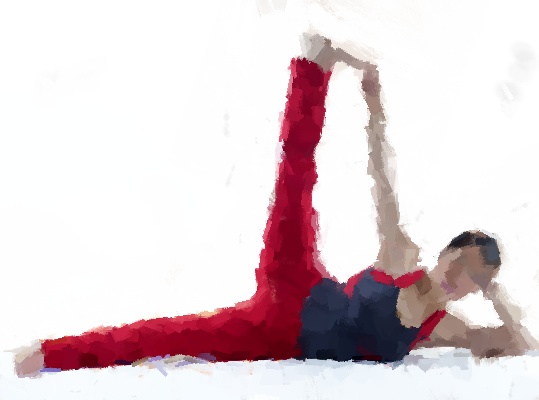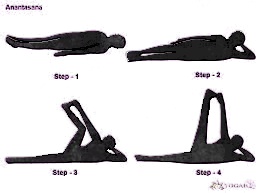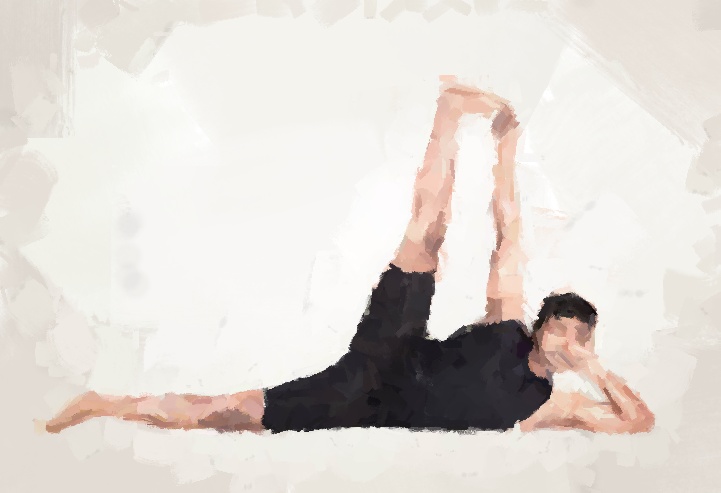Table of Contents
Introduction
Anantasana, also known as the Side-Reclining Leg Lift Pose, is a restorative yoga posture that provides a deep stretch to the hips, hamstrings, and lower back. This pose is named after the Hindu deity Ananta, who is often depicted as a serpent with infinite coils. Anantasana represents the infinite potential of the divine consciousness that resides within all of us. In this blog post, we will explore the Steps and benefits, variations, and modifications of Anantasana, as well as its spiritual significance.
The yogic philosophy of the Anantasana

Anantasana represents the infinite potential of the divine consciousness that resides within all of us. The serpent, or Ananta, is a symbol of the kundalini energy that lies coiled at the base of the spine. Through the practice of yoga, we can awaken this energy and experience a deeper connection with our true nature. Anantasana can help us to tap into this infinite potential and access a state of blissful consciousness.
Benefits of Anantasana
Anantasana offers a variety of physical, mental, and emotional benefits. Some of the main benefits of this pose include:

- Stretches the hips and hamstrings: Anantasana provides a deep stretch to the hips and hamstrings, which can help to alleviate tension and tightness in these areas.
- Strengthens the core: This pose engages the core muscles, which helps to improve balance and stability.
- Improves digestion: Anantasana can stimulate the digestive organs, which can aid in digestion and relieve constipation. Anantasana can help digestion by massaging the abdominal organs and promoting the flow of blood and oxygen to the digestive system.
- Reduces stress and anxiety: Practicing Anantasana can help to calm the mind and reduce stress and anxiety.
- Relieves menstrual cramps: This pose can be particularly beneficial for women who experience menstrual cramps, as it can help to alleviate tension and discomfort in the lower abdomen.
Infinite Yoga Pose: Step-by-Step Instructions
To practice Anantasana, follow these steps:

- Begin by lying on your right side with your legs extended and your head resting on your right arm.
- Bend your left knee and bring your left foot toward your buttocks.
- Reach your left hand behind you and grasp the outside of your left foot.
- On an inhale, lift your left leg up toward the ceiling.
- Straighten your left leg as much as possible, while keeping your right leg and hip on the ground.
- Hold the pose for 5-10 breaths, then release and repeat on the other side.
Advance Variations of Anantasana
Here are some variations of Anantasana that you can try:
- Modified Anantasana: If you have difficulty reaching your foot, you can place a strap around your foot and hold onto the strap instead.
- Half Anantasana: Instead of lifting your leg all the way up, you can keep your knee bent and lift your foot as high as you comfortably can.
- Full Anantasana: For a deeper stretch, you can extend both arms overhead and clasp your hands together, then lift your leg and upper body off the ground.
Modifications of Anantasana
Here are some modifications of Anantasana that you can try:

- Use a bolster or pillow under your head for support.
- Place a blanket or pillow under your bottom hip for added comfort.
- If you have knee pain, you can place a blanket or cushion under your knee.
- If you have lower back pain, you can bend your bottom knee and place your foot on the ground for added support.
Therapeutic Applications of Anantasana
Anantasana, or the side-reclining leg lift, has several therapeutic applications that make it a beneficial pose for people with a range of health conditions. Here are some therapeutic applications of Anantasana:
- Alleviates back pain: Anantasana helps to stretch and strengthen the muscles of the back, especially the lower back.
- Relieves sciatica: Sciatica is a painful condition caused by pressure on the sciatic nerve. Anantasana can help relieve sciatica pain by stretching and strengthening the muscles of the hips and lower back.
- Improves balance: Anantasana challenges balance and stability, which can help improve proprioception and reduce the risk of falls.
- Relieves menstrual discomfort: Anantasana can help alleviate menstrual discomfort by stretching and strengthening the muscles of the lower back and hips
- Helps with insomnia: Anantasana can help promote better sleep by reducing stress and tension in the body, and by promoting deep relaxation.
Poses Related to Anantasana
Anantasana, also known as the side-reclining leg lift, is a challenging yoga pose that requires flexibility, strength, and balance. To prepare your body for this pose, it can be helpful to practice some preparatory poses beforehand.
Preparatory Poses
Here are some preparatory poses for Anantasana:
- Supine Bound Angle Pose (Supta Baddha Konasana): This pose helps open up the hips and inner thighs, making it easier to stretch the legs in Anantasana.
- Reclining Hand-to-Big-Toe Pose (Supta Padangusthasana): This pose helps stretch the hamstrings and improve flexibility in the legs, which is necessary for Anantasana.
- Low Lunge (Anjaneyasana): This pose helps stretch the hip flexors and quads, which can make it easier to lift the leg in Anantasana.
Follow-up Poses
Here are some Follow-up Poses for Anantasana:
- Revolved Triangle Pose (Parivrtta Trikonasana): This pose helps strengthen the legs and improve balance, which is important for holding Anantasana.
- Tree Pose (Vrksasana): This pose helps improve balance and strengthen the legs, which can make it easier to hold Anantasana.
Beginner’s Tip of Anantasana
If you are new to Anantasana, here are some beginner’s tips to help you get started:
- Use props: It can be helpful to use props, such as a block or blanket, to support your head or hips in the pose. This can help you feel more comfortable and relaxed, and make it easier to hold the pose for longer.
- Start slow: Begin by practicing Anantasana for just a few breaths on each side, gradually building up to longer holds as you become more comfortable with the pose.
- Focus on your breath: As you hold the pose, focus on your breath and try to deepen your inhales and exhales. This can help calm your mind and relax your body.
- Keep your core engaged: To help maintain balance in the pose, engage your core muscles by drawing your belly button in towards your spine. This can also help protect your lower back.
- Modify the pose as needed: If you experience any discomfort or pain in the pose, modify it by bending your bottom knee or using props for support. Remember, it’s important to listen to your body and practice with awareness.
By following these beginner’s tips, you can gradually build your strength and flexibility in Anantasana and feel more confident in your yoga practice.
Contraindications and Cautions of Anantasana
While Anantasana is generally a safe pose for most people, there are some contraindications and cautions to keep in mind. Here are some things to consider before practicing Anantasana:
- Knee injuries: If you have a knee injury or discomfort, you should avoid practicing Anantasana or modify the pose by placing a blanket or cushion under your knee for support.
- Hip injuries: If you have a hip injury or discomfort, you should avoid practicing Anantasana or modify the pose by using a bolster or pillow under your head and placing a blanket or pillow under your bottom hip for added comfort.
- Lower back pain: If you have lower back pain, you should avoid practicing Anantasana or modify the pose by bending your bottom knee and placing your foot on the ground for added support.
- High blood pressure: If you have high blood pressure, you should practice Anantasana with caution and avoid holding your breath while in the pose.
- Pregnancy: If you are pregnant, you should practice Anantasana with caution and avoid lying on your back for extended periods of time. You can modify the pose by lying on your left side and placing a pillow or blanket between your legs for support.
Always listen to your body and practice with awareness. If you experience any pain or discomfort during the pose, you should come out of the pose and consult with a healthcare professional before continuing your yoga practice.
FAQ’s on Anantasana
Which type of asana is Anantasana?
Anantasana is a reclined asana that helps relieve fatigue and improve core stability. In this asana, the body reclines on one side, and the top leg is lifted and held with the top arm, as in an extended hand-to-big-toe pose (utthita hasta padangusthasana).
What Anantasana means?
Anantasana (Sanskrit: अनन्तासन; IAST: Anantāsana), Sleeping Vishnu Pose or Vishnu’s Couch Pose, Eternal One’s Pose, or Side-Reclining Leg Lift is an asana in modern yoga as exercise.
What are the contraindications for Anantasana?
Injury and Surgery: Students with injuries in the ankles, knees, and shoulders need to avoid this pose. Any stress or pain in the neck can be aggravated due to the neck alignment in this pose. Also, the pose should be avoided by people who have undergone knee, hip, or spinal surgeries.
Conclusion
While Anantasana can be challenging, it is important to approach the pose with awareness and patience, taking the time to prepare your body with preparatory poses and modifications as needed. By practicing regularly and listening to your body, you can gradually build your strength and flexibility, and enjoy the many benefits that Anantasana has to offer.
As with any yoga pose, it is important to practice with mindfulness and awareness, and to respect your body’s limits and abilities. With consistent practice and dedication, Anantasana can help you deepen your yoga practice and enhance your overall health and wellbeing.
Further reading on Anantasana
If you are interested in learning more about Anantasana, there are several resources available that can help you deepen your understanding of the pose and its benefits. “Light on Yoga” by B.K.S. Iyengar: This classic yoga text includes a detailed description and illustration of Anantasana, as well as modifications and variations of the pose.
References
- https://www.indianculture.gov.in/system/files/digitalFilesICWeb/ICrarebooks/cslrepository/4705/AS-000567_Part4.pdf
- https://www.ncbi.nlm.nih.gov/pmc/articles/PMC5786150/
- https://www.ncbi.nlm.nih.gov/pmc/articles/PMC4339138/
- https://www.ncbi.nlm.nih.gov/pmc/articles/PMC4475706/
- https://www.ncbi.nlm.nih.gov/pmc/articles/PMC4482438/
